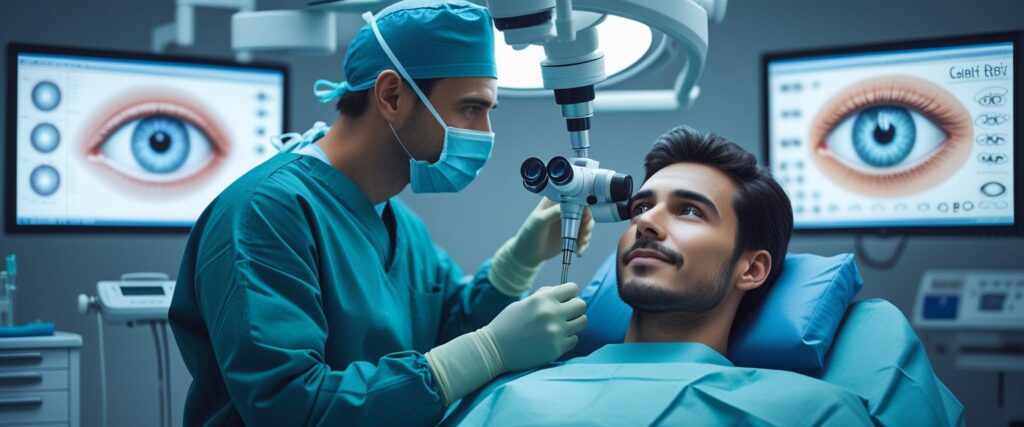If you’re exploring Amblyopia Surgery: Key Facts, Costs, Results & Global Insights, you’re likely searching for clear, trustworthy information about how this advanced procedure helps improve eye alignment and coordination. Amblyopia—commonly known as “lazy eye”—can significantly affect both vision and confidence, but surgical correction offers new hope for many patients worldwide.

This guide on Amblyopia Surgery: Key Facts, Costs, Results & Global Insights provides an in-depth look at how the operation works, who can benefit, and what kind of recovery and results to expect. Backed by expert ophthalmologists and patient experiences, this article aims to help you make an informed, confident decision before pursuing treatment—whether locally or abroad.
Amblyopia Surgery: What You Must Know
Amblyopia surgery focuses on correcting eye alignment and related muscle issues rather than directly restoring vision lost from lazy eye. It often complements other treatments such as corrective lenses, patching, or vision therapy to improve coordination between the eyes.
Amblyopia surgery helps align the eyes and improve coordination when one eye is weaker than the other. While it doesn’t directly cure amblyopia, it can correct underlying issues such as strabismus or droopy eyelids that contribute to the condition. This procedure can enhance eye alignment, improve depth perception, and support other lazy eye treatments for better long-term results.
Many people considering this surgery want to understand what to expect, how effective it is, and whether it’s worth the cost. The article explores key facts about amblyopia surgery, including its benefits, success rates, and recovery process. It also examines how adults in 2025 can approach treatment and where to find affordable surgery options worldwide.

With insights from ophthalmologists and real patient experiences, this guide offers a clear look at how amblyopia surgery works, what results to expect, and how to prepare for recovery. It aims to help anyone considering the procedure make an informed and confident decision.
Understanding Amblyopia and Lazy Eye
Amblyopia, often called lazy eye, occurs when one eye develops weaker vision because the brain favors the other. It usually begins in early childhood and affects how the brain and eye work together. Common causes include strabismus, refractive error, or deprivation amblyopia from cataracts or droopy eyelids.
Treatment aims to strengthen the weaker eye and restore balance. This may involve eyeglasses, eye patches, or atropine drops to blur the stronger eye. In some cases, surgery corrects underlying physical causes that prevent proper alignment or clear vision.

If left untreated, amblyopia can cause permanent visual impairment in the affected eye. Early detection and consistent treatment improve long-term results.
Difference Between Amblyopia and Strabismus
Amblyopia and strabismus are related but distinct. Amblyopia refers to reduced vision in one eye due to poor brain-eye coordination. Strabismus means the eyes are misaligned, turning inward, outward, upward, or downward.
Strabismus can cause amblyopia when the brain ignores input from the misaligned eye. However, not all people with amblyopia have visible eye misalignment.

Amblyopia treatment focuses on retraining the brain to use both eyes, while strabismus surgery repairs the eye muscles to improve alignment. According to the American Academy of Ophthalmology, surgery can enhance appearance and depth perception but may not fully restore vision if amblyopia developed early.
Understanding the difference helps patients and caregivers choose the right combination of therapies for better outcomes.
How Amblyopia Surgery Works
Lazy eye surgery targets the eye muscles, not the retina or optic nerve. The surgeon adjusts the muscles that control eye movement to align both eyes properly. This procedure, known as strabismus surgery, can involve weakening or tightening specific muscles.
The operation usually takes 45 minutes to 2 hours under general anesthesia. As described by Vision Center, the surgeon makes a small incision on the eye’s surface, repositions the muscles, and closes the tissue with dissolvable stitches.

Patients typically go home the same day. Recovery includes antibiotic and steroid drops, with full healing in about six weeks. Postoperative visits ensure the eyes remain aligned and healing progresses normally.
Who Is a Candidate for Amblyopia Surgery
Surgery is most effective for patients whose amblyopia results from strabismus or structural issues like droopy eyelids or cataracts. Children benefit most because their visual system is still developing, making it easier to retrain the brain after alignment correction.
Adults may undergo surgery for cosmetic reasons or to improve eye coordination, but vision improvement is limited. The American Academy of Ophthalmology notes that adult surgery can straighten the eyes but rarely restores normal sight in the amblyopic eye.

Candidates must complete a full eye exam, including muscle testing and health screening. Doctors often recommend trying non-surgical methods first, such as corrective lenses or patch therapy, before considering surgery.
Benefits and Success Rate of Amblyopia Surgery
Amblyopia surgery focuses on improving eye alignment, reducing strain, and supporting better binocular vision. While it does not directly restore vision lost from amblyopia, it can correct crossed eyes or muscle imbalance, helping patients achieve a more natural appearance and improved coordination between the eyes.
Top Benefits of Amblyopia Surgery
Amblyopia surgery often involves eye muscle surgery to adjust the muscles that control eye movement. This can help the eyes move together more smoothly and appear properly aligned. According to Vision Center, this procedure may also reduce eye fatigue and improve depth perception.
Common benefits include:
- Better eye alignment and appearance
- Reduced eye strain during reading or focusing
- Enhanced comfort in daily visual tasks

Children usually experience stronger results because their visual systems are still developing. Adults may still see cosmetic and functional improvements, though vision in the weaker eye typically remains limited.
Amblyopia Surgery Success Rate: What to Expect
Success depends on the type of amblyopia, patient age, and whether other treatments like glasses or patching were used earlier. Studies show that early intervention leads to higher success rates. For instance, children under seven respond best to combined therapy involving surgery and visual training.
Eye muscle surgery for strabismus-related amblyopia often achieves cosmetic alignment in about 80% of cases, though some patients need a second operation. As noted by the American Academy of Ophthalmology, adults may benefit mainly from improved alignment rather than vision recovery.

Doctors measure success by improved alignment, reduced double vision, and easier binocular coordination rather than restored visual acuity.
How Surgery Can Improve Eye Alignment
During surgery, the ophthalmologist weakens or strengthens specific eye muscles to reposition the eyes. This adjustment helps both eyes point in the same direction, reducing eye misalignment or crossed eyes.
The procedure typically lasts less than two hours under general anesthesia. Dissolvable stitches are used, and most patients recover within a few weeks. Postoperative care includes antibiotic and steroid drops to prevent infection and control swelling.

Better alignment allows the brain to coordinate input from both eyes more effectively. This can make reading, driving, and other visual tasks easier and less tiring over time.
Impact on Depth Perception and Vision Quality
Surgery can enhance depth perception by aligning the eyes, allowing them to work together more effectively. While it cannot reverse vision loss caused by amblyopia itself, it can improve how the eyes cooperate, which supports better spatial awareness.
Improved alignment helps the brain process three-dimensional information more accurately. This can reduce double vision, improve balance, and make everyday tasks like catching a ball or walking on uneven ground easier.

In children, these gains are often greater because their visual systems are still adaptable. Adults may notice subtler improvements, especially in tasks that depend on coordinated eye movement and depth cues.
Amblyopia Surgery in Adults: 2025 Guide
Adults with amblyopia often seek surgery to correct eye alignment or improve appearance. While surgery cannot restore lost vision from childhood amblyopia, it can align the eyes, reduce double vision, and support better binocular balance when combined with other treatments like vision therapy.
Amblyopia Surgery for Adults: Key Considerations
Amblyopia, or “lazy eye,” develops when one eye fails to communicate properly with the brain during early childhood. In adults, the visual loss is usually permanent, but surgery may still help manage related conditions like strabismus.
Eye muscle surgery adjusts the muscles that control eye position. This type of procedure can improve alignment but does not directly fix the weak vision caused by amblyopia. The American Academy of Ophthalmology notes that such surgery mainly improves cosmetic appearance and eye coordination.

Adults with mild amblyopia may also benefit from laser correction, such as LASIK or PRK, to reduce dependence on glasses. However, these procedures only make the weaker eye see as well as it could with corrective lenses, not restore normal sight.
Before and After: Real Results in Adults
Before surgery, ophthalmologists perform detailed exams to measure eye alignment, muscle strength, and binocular function. Patients with strabismus-related amblyopia often choose surgery to straighten their eyes and improve appearance or depth perception.
After surgery, eyes typically appear more aligned, and some patients notice reduced eye strain or improved comfort. According to Vision Center, outcomes depend on the cause of amblyopia and the patient’s overall eye health.

Post-surgery recovery involves using eye drops, avoiding heavy activity, and sometimes following up with vision therapy or eye patch exercises to help the brain adapt to the new alignment. Results vary, but most adults report better confidence and easier eye coordination.
Doctor Insights: Is Amblyopia Surgery Worth It?
Ophthalmologists emphasize that amblyopia surgery in adults is most useful for cosmetic and functional alignment, not for restoring lost vision. The Cleveland Clinic explains that while brain plasticity is limited after childhood, some adults may still gain modest improvements in visual balance.
Doctors often recommend combining surgery with non-surgical treatments like vision therapy, which trains the brain to use both eyes together. This combined approach may enhance depth perception and reduce eye fatigue.

For many adults, the decision depends on goals. Those seeking improved appearance or comfort often find surgery worthwhile, while others focused on vision restoration may not see significant change.
Costs, Recovery, and Global Options for Amblyopia Surgery
Amblyopia surgery costs vary widely depending on the cause, surgical technique, and country. Patients often consider both price and quality of care. Recovery usually involves short-term discomfort and follow-up therapy to improve alignment and vision.
Amblyopia Surgery Cost Overview
The cost of amblyopia surgery depends on the underlying issue being corrected, such as strabismus or droopy eyelids. In the United States, prices typically range from $3,500 to $7,000 per eye, including surgeon fees, anesthesia, and facility costs.
Insurance may cover part of the expense if the surgery is medically necessary. Procedures like eye muscle surgery for alignment often qualify, while cosmetic corrections may not.

Some clinics offer payment plans or discounts for multiple procedures. According to Vision Center, amblyopia-related surgery targets muscle imbalance rather than the amblyopia itself, which can affect total cost.
| Region | Estimated Cost (USD) | Notes |
|---|---|---|
| United States | $3,500–$7,000 | Varies by hospital and surgeon |
| United Kingdom | $2,800–$5,000 | NHS may cover part of treatment |
| India | $1,000–$2,500 | Lower labor and facility costs |
| Thailand | $1,500–$3,000 | Popular for medical tourism |
Best Countries for Affordable Amblyopia Surgery
Countries like India, Thailand, and Turkey are known for affordable amblyopia and eye muscle surgery. These destinations combine lower costs with skilled ophthalmologists and modern facilities.
Patients often travel for care due to savings of 40–70% compared to Western countries. Hospitals in India and Thailand frequently offer surgery packages that include pre-op testing, accommodation, and post-op care.

According to CancerFax, treatment costs in Asian countries are significantly lower than in the United States or Europe while maintaining good clinical outcomes. Patients should still verify surgeon credentials and facility accreditation before booking surgery abroad.
Recovery Tips and Side Effects You Should Know
Recovery after amblyopia or eye muscle surgery usually takes one to two weeks. Mild redness, swelling, or double vision can occur during healing. Doctors often prescribe antibiotic or anti-inflammatory drops to prevent infection.
Patients should avoid swimming, eye rubbing, and strenuous activity for at least a week. Follow-up visits help monitor alignment and healing progress.

Common side effects include temporary irritation or blurred vision. In rare cases, overcorrection or undercorrection may require additional surgery. The London Squint Clinic notes that adults can achieve improved alignment and vision stability with proper post-surgery therapy, especially when combined with visual training for refractive error correction.
Conclusion
Understanding Amblyopia Surgery: Key Facts, Costs, Results & Global Insights can help patients and caregivers take the right step toward better eye alignment, improved depth perception, and enhanced quality of life. While the surgery doesn’t directly restore lost vision, it plays a vital role in correcting structural issues and supporting other lazy-eye therapies for long-term improvement.
By reviewing Amblyopia Surgery: Key Facts, Costs, Results & Global Insights, you gain a well-rounded perspective on effectiveness, pricing differences across countries, and post-surgery outcomes. Whether you’re considering surgery for functional or cosmetic reasons, being informed is the first step toward seeing the world more clearly—both literally and confidently.
Frequently Asked Questions about Amblyopia Surgery
How much is surgery to correct a lazy eye?
The cost of Amblyopia Surgery: Key Facts, Costs, Results & Global Insights depends on the underlying condition being treated — typically strabismus (eye misalignment) or droopy eyelids that contribute to amblyopia.
In the United States, the average price ranges between $3,500 and $7,000 per eye, depending on the hospital, surgeon experience, and anesthesia costs. In countries such as India, Thailand, or Turkey, the same procedure can cost between $1,000 and $3,000, making them popular destinations for affordable eye treatments and medical tourism.
Some insurance plans cover surgery if it’s deemed medically necessary (for example, correcting strabismus), but cosmetic procedures may not be included. Always confirm the inclusions — such as consultation, operation, anesthesia, and post-op care — before booking.
What is the new treatment for amblyopia?
Recent advancements in Amblyopia Surgery: Key Facts, Costs, Results & Global Insights go beyond traditional patching and vision therapy. New research focuses on digital and neuroplasticity-based treatments that retrain the brain to use the weaker eye more effectively.
Some emerging therapies include:
- Virtual Reality (VR) vision training — immersive exercises that stimulate both eyes simultaneously.
- Binocular video games — interactive treatments that improve coordination and visual balance.
- Atropine drops and light therapy — designed to blur the stronger eye temporarily, encouraging use of the weaker one.
While these new methods improve brain-eye communication, they are often combined with surgery if physical alignment problems exist. The combination of surgery and neuro-visual therapy gives the most comprehensive results for both children and adults.
What is the success rate of amblyopia surgery?
The success rate of amblyopia surgery varies depending on age, underlying cause, and treatment type. According to global studies and Amblyopia Surgery: Key Facts, Costs, Results & Global Insights, eye alignment success is achieved in approximately 75–85% of cases after one surgery.
Children generally experience better long-term improvements because their visual systems are still adaptable. In adults, success often focuses on cosmetic correction, improved coordination, and reduced eye strain rather than vision restoration. Some patients may require a second operation for optimal alignment, particularly if the eye muscles adjust over time.
How long does amblyopia surgery take?
Amblyopia surgery—also called eye muscle or strabismus surgery—is typically a short outpatient procedure lasting 45 minutes to 2 hours.
The surgery is performed under general anesthesia. The ophthalmologist makes a small incision on the eye’s surface to either tighten or loosen the muscles controlling movement, ensuring proper alignment.
After surgery, most patients go home the same day, with full recovery taking about 4–6 weeks. Postoperative care includes using prescribed eye drops to prevent infection and reduce inflammation.
Can amblyopia be corrected in adults?
While amblyopia (lazy eye) develops during childhood, adults can still benefit from targeted treatments. Surgical correction doesn’t directly fix lost vision, but it can improve eye alignment, depth perception, and coordination, especially when combined with vision therapy.
Recent studies show that adults may experience partial visual improvement thanks to the brain’s residual plasticity, even after years of untreated amblyopia. Therefore, while complete restoration is rare, functional and cosmetic improvements are absolutely achievable.
Does lazy eye surgery work for adults?
Yes. Lazy eye (amblyopia) surgery works effectively for adults — especially those whose condition is linked to strabismus (misalignment). Although it doesn’t “cure” amblyopia, surgery can straighten the eyes, reduce double vision, and enhance binocular balance.
For many adults, the biggest benefit is aesthetic improvement and confidence restoration. When paired with visual therapy exercises, patients often notice improved comfort while reading, driving, or using digital screens. According to ophthalmologists, more than 70% of adult patients report satisfaction with their results post-surgery.
What age is too late for amblyopia surgery?
Technically, there’s no upper age limit for amblyopia-related surgery. However, the outcomes differ between children and adults.
- Children (below 7 years) — best results due to high brain adaptability.
- Teens and Adults — can still achieve alignment correction and cosmetic improvements, but vision recovery may be limited.
The procedure remains safe at any age, provided the patient is in good general health and understands the expected outcomes. Most ophthalmologists evaluate each case individually before recommending surgery.
Can amblyopia be treated by surgery?
Surgery does not directly cure amblyopia because the condition originates in the brain’s processing of visual input, not the eyes themselves. However, it treats the underlying causes, such as strabismus (misaligned eyes) or ptosis (droopy eyelid), which contribute to the development of amblyopia.
Once alignment is corrected, the brain can relearn to use both eyes together, especially when followed by vision therapy, patching, or corrective lenses. In essence, surgery is a supportive treatment that helps other therapies become more effective, leading to better long-term results and improved visual coordination.
